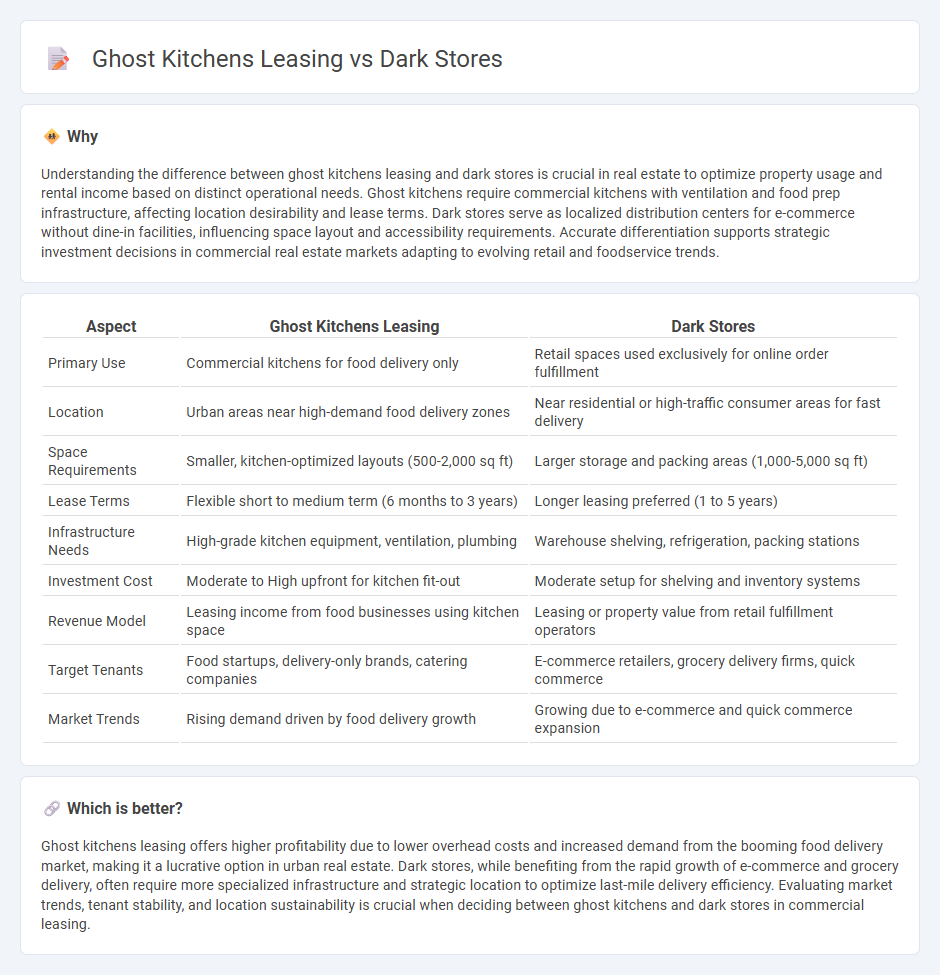
Ghost kitchens leasing offers flexible, low-cost real estate solutions for food delivery businesses, optimizing urban spaces for high-demand markets. Dark stores, converted from traditional retail spaces, serve as localized fulfillment centers designed to expedite e-commerce order processing with minimal foot traffic. Explore how these innovative real estate strategies are transforming the landscape of retail and food service logistics.
Why it is important
Understanding the difference between ghost kitchens leasing and dark stores is crucial in real estate to optimize property usage and rental income based on distinct operational needs. Ghost kitchens require commercial kitchens with ventilation and food prep infrastructure, affecting location desirability and lease terms. Dark stores serve as localized distribution centers for e-commerce without dine-in facilities, influencing space layout and accessibility requirements. Accurate differentiation supports strategic investment decisions in commercial real estate markets adapting to evolving retail and foodservice trends.
Comparison Table
| Aspect | Ghost Kitchens Leasing | Dark Stores |
|---|---|---|
| Primary Use | Commercial kitchens for food delivery only | Retail spaces used exclusively for online order fulfillment |
| Location | Urban areas near high-demand food delivery zones | Near residential or high-traffic consumer areas for fast delivery |
| Space Requirements | Smaller, kitchen-optimized layouts (500-2,000 sq ft) | Larger storage and packing areas (1,000-5,000 sq ft) |
| Lease Terms | Flexible short to medium term (6 months to 3 years) | Longer leasing preferred (1 to 5 years) |
| Infrastructure Needs | High-grade kitchen equipment, ventilation, plumbing | Warehouse shelving, refrigeration, packing stations |
| Investment Cost | Moderate to High upfront for kitchen fit-out | Moderate setup for shelving and inventory systems |
| Revenue Model | Leasing income from food businesses using kitchen space | Leasing or property value from retail fulfillment operators |
| Target Tenants | Food startups, delivery-only brands, catering companies | E-commerce retailers, grocery delivery firms, quick commerce |
| Market Trends | Rising demand driven by food delivery growth | Growing due to e-commerce and quick commerce expansion |
Which is better?
Ghost kitchens leasing offers higher profitability due to lower overhead costs and increased demand from the booming food delivery market, making it a lucrative option in urban real estate. Dark stores, while benefiting from the rapid growth of e-commerce and grocery delivery, often require more specialized infrastructure and strategic location to optimize last-mile delivery efficiency. Evaluating market trends, tenant stability, and location sustainability is crucial when deciding between ghost kitchens and dark stores in commercial leasing.
Connection
Ghost kitchens and dark stores share a significant connection through their reliance on specialized real estate leasing in urban areas. Both concepts utilize minimal physical storefront space, focusing instead on optimized kitchen and storage facilities designed for delivery services. This shift influences lease structures, favoring flexible, cost-efficient spaces in strategic locations to maximize operational efficiency and reduce overhead costs.
Key Terms
Zoning Regulations
Dark stores typically require commercial zoning that supports retail distribution and last-mile delivery, while ghost kitchens must comply with food service zoning laws emphasizing health and safety regulations. Leasing for dark stores demands proximity to urban centers to optimize delivery logistics, whereas ghost kitchens often seek locations with infrastructure for efficient food preparation and dispatch. Explore further to understand how zoning nuances impact leasing strategies for both dark stores and ghost kitchens.
Triple Net Lease (NNN)
Dark stores and ghost kitchens primarily operate under Triple Net Lease (NNN) agreements, where tenants are responsible for rent, property taxes, insurance, and maintenance costs, optimizing operational control and cost predictability. This leasing model benefits dark stores by ensuring flexible use of retail spaces, while ghost kitchens leverage it for scalable kitchen infrastructure without retail front expenses. Explore how Triple Net Lease arrangements uniquely support the dynamic growth of dark stores and ghost kitchens in today's retail and foodservice industries.
Occupancy Permit
Dark stores and ghost kitchens require specific occupancy permits to operate legally in commercial spaces, with regulations varying by municipality and zoning laws. Dark stores typically need permits aligned with retail or storage use, while ghost kitchens must obtain certifications for food preparation and health compliance. Explore our in-depth guide to understand the leasing requirements and streamline the occupancy permit process for your business.
Source and External Links
What Is a Dark Store? - NetSuite - A dark store is a repurposed brick-and-mortar store or warehouse used exclusively for fulfilling online orders, often located in suburbs and designed for efficient picking and packing without customers shopping inside.
Dark stores in retail: Concept, benefits, challenges, strategies 2025 - Dark stores operate like warehouses specially optimized for online order fulfillment, supporting quick picking, packing, and delivery to meet the rising demand for eCommerce convenience and rapid delivery.
Dark store - Wikipedia - A dark store is a distribution center or retail outlet exclusively for online shopping, typically large warehouses facilitating click-and-collect or delivery, a concept that originated in the UK and expanded globally with the growth of online grocery delivery.
 dowidth.com
dowidth.com